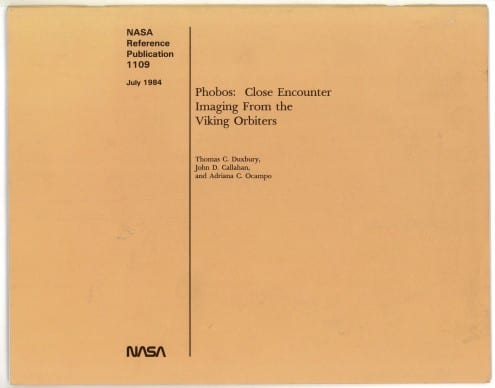Close encounters with fear and dread
By Oli Usher, on 8 September 2014
This week’s Picture of the Week comes from UCL’s planetary science archives, and their rich collection of early NASA space images. Many of these are not available anywhere online, and some of them are hidden behind rather unpromising covers (see above).
The Viking missions to Mars, two identical spacecraft launched a few weeks apart in 1975, are well known for making the first successful landings on the surface of the red planet. But the Viking orbiters were important too, mapping the surface of the planet and observing its moons, Phobos (fear) and Deimos (dread).
This NASA book from 1984, entitled Phobos: Close Encounter Imaging from the Viking Orbiters is a comprehensive album of the observations the programme made of Phobos, the larger of the two moons.
This picture shows a typical spread, produced during the flyby of Phobos on May 26, 1977 by Voyager Orbiter 1.
Although it is the larger of the two moons of Mars, Phobos is still very small, and seems likely to be an asteroid captured by Mars’ gravity, rather than a moon formed at the same time as its parent planet.
A fraction of the size of Earth’s Moon, its gravity is not strong enough to have pulled it into a sphere, leaving the irregularly-shaped object visible here.
A Russian mission to land on Phobos and return a sample to Earth, Fobos-Grunt, malfunctioned shortly after launch in November 2011 and never left Earth orbit.
Links
- UCL Regional Planetary Image Facility
- Snapshots from Space History (more photos from UCL’s planetary science archives)
- UCL Centre for Planetary Sciences
- Videos and photos of Phobos and Deimos seen from the Martian surface, taken by the Curiosity Rover
 Close
Close




